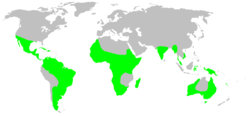Deinopidae
| Deinopidae | |
|---|---|
 | |
| Deinopis sp. with web | |
| Scientific classification | |
| Kingdom: | Animalia |
| Phylum: | Arthropoda |
| Class: | Arachnida |
| Order: | Araneae |
| Suborder: | Araneomorphae |
| Superfamily: | Deinopoidea |
| Family: | Deinopidae C. L. Koch, 1850 |
| Genera | |
| Diversity[1] | |
| 2 genera, 61 species | |
 | |
The spider family Deinopidae consists of stick-like elongate spiders that build unusual webs that they suspend between the front legs. When prey approaches, the spider will stretch the net to two or three times its relaxed size and propel itself onto the prey, entangling it in the web. Because of this, they are also called net-casting spiders. Their excellent night-vision adapted posterior median eyes allow them to cast this net over potential prey items. These eyes are so large in comparison to the other six eyes that the spider seems to have only two eyes.
The genus Deinopis is the best known in this family. Spiders in this genus are also called ogre-faced spiders, due to the imagined similarity between their appearance and that of the mythological creature, the ogre. It is distributed nearly worldwide in the tropics, from Australia to Africa and the Americas. In Florida, Deinopis often hangs upside-down from a silk line under palmetto fronds during the day. It emerges at night to practice its unusual prey capture method on invertebrate prey.
The genus Menneus is also known as "humped-back spider".
The entire family is cribellate.[2]
Genera
- Deinopis Macleay, 1839 (on every continent, except Europe and Antarctica)
- Menneus Simon, 1876 (Australia, Africa)
Two genera formerly included in this family, Avella O. P-Cambridge, 1877 and Avellopsis Purcell, 1904, are now placed in Menneus.[3]
See also
References
- ↑ "Currently valid spider genera and species", World Spider Catalog (Natural History Museum Bern), retrieved 2015-09-28
- ↑ Coddington, J.A. & Levi, H.W. (1991). Systematics and Evolution of Spiders (Araneae). Annu. Rev. Ecol. Syst. 22:565-592
- ↑ "Gen. Menneus Simon, 1876", World Spider Catalog (Natural History Museum Bern), retrieved 2015-09-28
External links
| Wikispecies has information related to: Deinopidae |